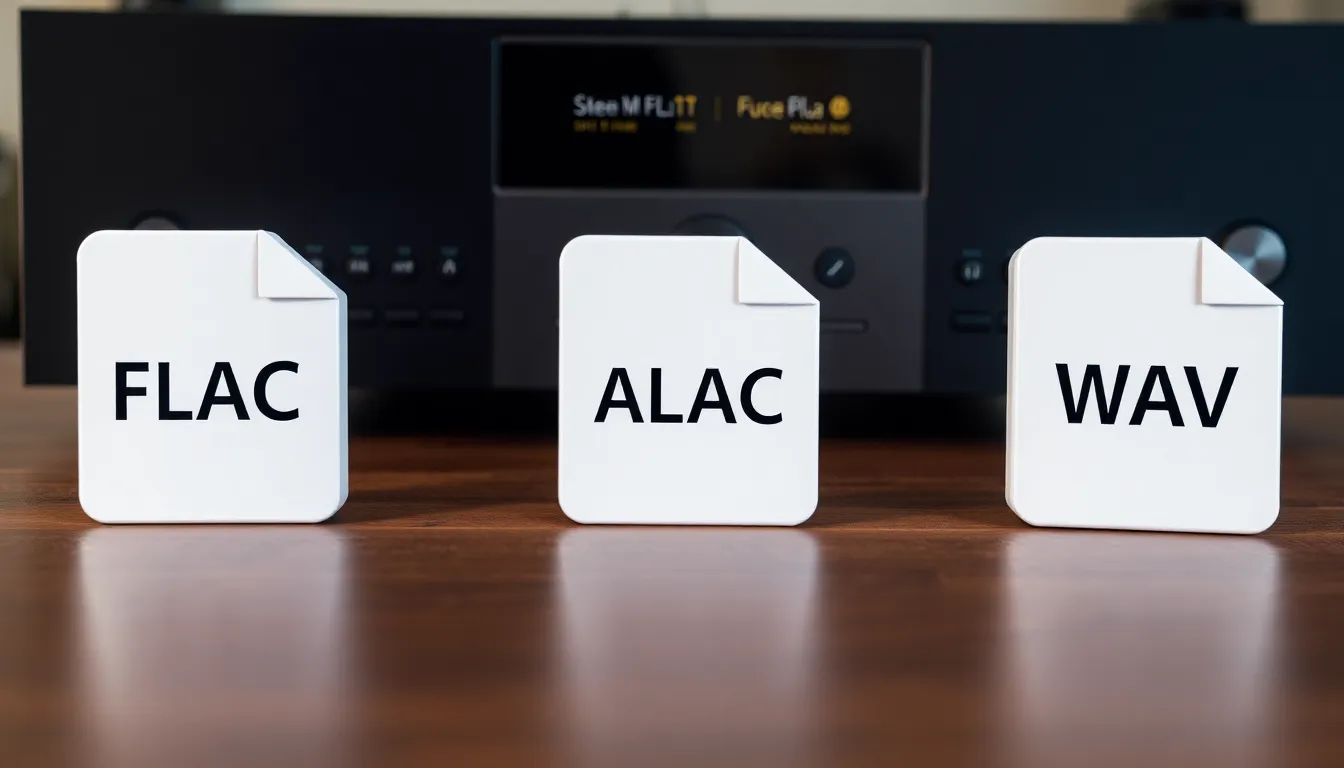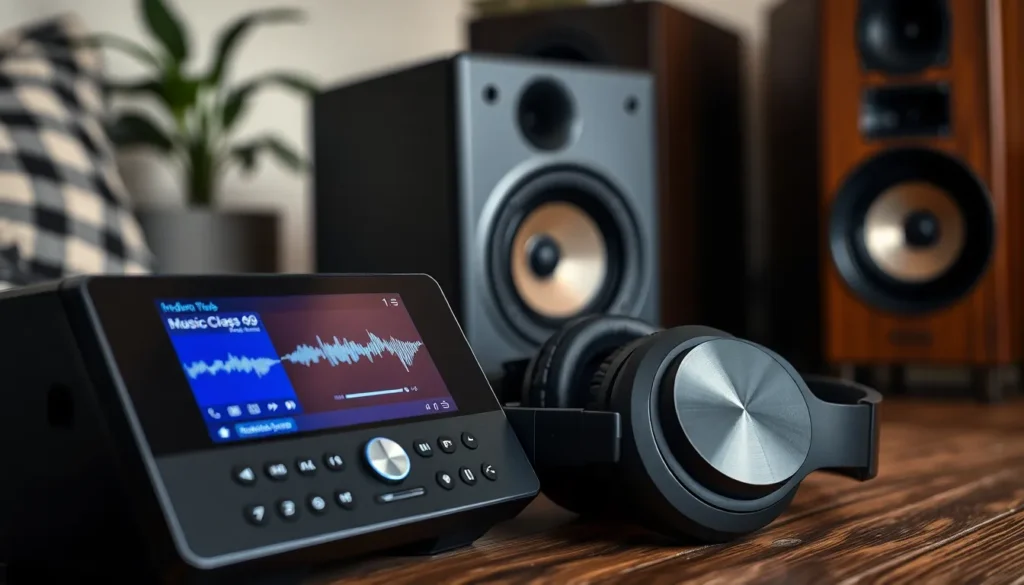Imagine diving into a world of sound so rich and detailed that you can almost hear the artist’s heart beating in the background. Lossless audio formats make this dream a reality. Unlike their lossy counterparts, which compress music into tiny, unrecognizable blobs, lossless formats preserve every note, every nuance, and every ounce of emotion. It’s like trading in your old flip phone for the latest smartphone—suddenly, everything sounds better.
Overview Of Lossless Audio Formats
Lossless audio formats preserve the original quality of sound during compression. Common examples include FLAC (Free Lossless Audio Codec), ALAC (Apple Lossless Audio Codec), and WAV (Waveform Audio File Format). Each format retains all audio data, creating an experience similar to the original recording.
FLAC stands out for its efficient compression, reducing file sizes without losing quality. ALAC offers compatibility with Apple devices, making it ideal for users within the Apple ecosystem. WAV provides an uncompressed format, resulting in larger file sizes but optimal sound fidelity.
Listeners benefit from the rich detail and dynamic range that lossless formats deliver. These formats ensure that subtle nuances such as a guitar’s strum or a vocalist’s breath are captured accurately. Audiophiles prefer lossless formats for this very reason, as they demand the highest sound quality.
Platforms, including Tidal and Qobuz, offer streaming services featuring lossless audio options. These services allow users to experience high-resolution music without compromising fidelity. Lossless formats have gained popularity in recent years as more individuals prioritize audio quality over file size.
Lossless audio formats cater to serious music enthusiasts who seek an authentic listening experience. The commitment to maintaining audio integrity sets them apart from their lossy counterparts. Understanding these formats enhances one’s appreciation for music, allowing listeners to engage with their favorite tracks at a deeper level.
Common Lossless Audio Formats

Lossless audio formats preserve the original sound quality, making them essential for serious music enthusiasts. Here are some of the most notable formats available.
FLAC (Free Lossless Audio Codec)
FLAC compresses audio data without sacrificing sound quality. It is both efficient and provides substantial file size reductions, making it popular among audiophiles. Support for metadata allows users to include information about the artist and album. Many devices, including smartphones and computers, support FLAC playback. This versatility helps maintain audio fidelity in various settings. Accessibility on streaming platforms boosts its popularity even further, illustrating its growing acceptance in mainstream music consumption.
ALAC (Apple Lossless Audio Codec)
ALAC offers lossless compression similar to FLAC but is tailored for Apple devices. This format allows seamless integration with iTunes and ensures high compatibility across Apple’s ecosystem. Playback on iPhones, iPads, and Macs remains flawless, allowing users to enjoy music without quality losses. Additionally, ALAC files maintain metadata, enhancing the overall music experience. It caters specifically to Apple users seeking uncompromised audio quality, reinforcing the brand’s dedication to high-fidelity sound.
WAV (Waveform Audio File Format)
WAV represents an uncompressed audio format that delivers the highest level of sound fidelity. Its lack of compression results in larger file sizes, which may deter some users. Nevertheless, professional studios often prefer WAV for its pristine audio representation. This format provides full fidelity for recording and editing workflows in music production. Compatibility with virtually all audio playback devices makes WAV a reliable choice. Many audiophiles appreciate its integrity, ensuring that the original sound remains unharmed throughout playback.
Benefits Of Lossless Audio Formats
Lossless audio formats offer distinct advantages, particularly for those deeply immersed in their music experience. The benefits extend beyond mere enjoyment, enhancing how listeners perceive sound.
Superior Sound Quality
Engaging with lossless audio formats ensures a higher level of sound quality. Every note resonates clearly, allowing listeners to appreciate intricate details within a track. Audiophiles praise the ability to capture subtle nuances, which enhances an emotional connection to the music. Compared to lossy formats, lossless retains the full range of frequencies, creating a more dynamic listening experience. Many listeners find that the absence of compression artifacts leads to a targeted clarity that brings music to life.
Preservation Of Original Audio
Maintaining the integrity of original audio is a significant benefit of lossless formats. These formats capture the complete audio data, preserving artists’ intended sound. Metadata support provides additional context, delivering relevant information about the track and enhancing the overall listening experience. This level of preservation is particularly valuable for professionals in the audio industry and avid music fans who seek authenticity. Formats like FLAC and ALAC exemplify this commitment to maintaining true audio fidelity, appealing to those who prioritize quality in their collections.
Use Cases For Lossless Audio Formats
Lossless audio formats cater to various scenarios that demand superior sound quality. Two primary use cases stand out: audiophile listening and professional audio production.
Audiophile Listening
Audiophiles prioritize sound quality above all else. They seek the purest audio experience, which lossless formats provide. FLAC and ALAC are popular choices for those wanting to hear every nuance in their favorite tracks. Enhanced clarity offered by these formats allows listeners to connect deeply with the music. Engaging with high-resolution files enables audiophiles to appreciate the subtleties that lossy formats obscure. Accessing dedicated streaming services like Tidal and Qobuz enriches their experience, as these platforms focus on lossless options. Every detail captured in the music amplifies their enjoyment and appreciation of the art form.
Professional Audio Production
Professional audio producers rely on lossless formats for high-fidelity sound. WAV and FLAC files become essential tools during recording and mixing processes. Uncompressed audio provides unmatched clarity, ensuring that every aspect of a recording stands out. Maintaining the original audio integrity is crucial when working on sensitive projects. Producers value lossless formats for their ability to capture intricate soundscapes without compromise. The metadata support built into these formats also assists in efficient track management. Each element contributes to a polished final product that meets industry standards, making lossless audio formats indispensable in professional settings.
Lossless audio formats stand out as the go-to choice for those who value sound quality and emotional connection in music. By preserving the original audio data, formats like FLAC, ALAC, and WAV allow listeners to experience music as the artists intended. This dedication to audio fidelity not only enhances personal enjoyment but also supports professionals in achieving the highest standards in sound production. As streaming services increasingly adopt lossless options, the trend toward prioritizing audio quality over convenience is evident. Embracing lossless formats opens a world of rich musical detail that enriches the listening experience for everyone.






